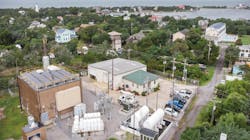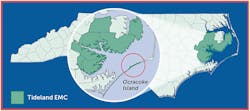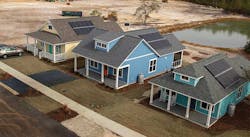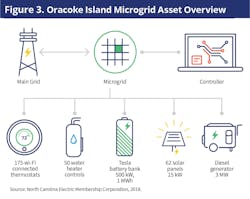Microgrids Strengthen Coastal Resiliency
The Outer Banks are a string of peninsulas and barrier islands running along the coast of North Carolina that separate the Atlantic Ocean from the U.S. mainland. They are home to long expanses of beautiful beaches, the historic first flight in Kitty Hawk and the state’s first utility microgrid.
The unique geographical location of the Outer Banks — the way it juts out from the Eastern Seaboard — makes it one of the most hurricane-prone areas in the U.S. One of its most remote islands, Ocracoke Island, is especially vulnerable to power outages from high winds and flooding as well as because of its isolation from central generation sources. If the single power line feeding the island is without service because of storms or other circumstances, the entire island could be without power. Electric service to the island is fed on a 75-mile (121-km) radial line that starts in Nags Head and includes four voltage changes and two underground cables. Historically, the island has relied on a diesel generator for backup power.
Ocracoke Island is served by Tideland Electric Membership Corp. (Tideland EMC), the power provider for 22,000 cooperative members on the island and in six coastal counties. Tideland EMC procures wholesale power from North Carolina Electric Membership Corp. (NCEMC), the co-op power supply organization serving most of North Carolina’s distribution co-ops. North Carolina has 26 distinct member-owned, not-for-profit electric co-ops that serve approximately 2.5 million people in 93 of the state’s 100 counties, many of which are in coastal and rural regions. Recognizing opportunities to enhance service — while also studying emerging grid technologies — NCEMC and its member co-ops have focused on developing tools and solutions, like microgrids, to make their coastal systems more resilient. Microgrids are small electric systems that combine local energy resources, technologies, and microgrid controls to provide power to a defined area. These microgrids typically remain connected to the main grid but can operate independently.
An Islanded State
The idea for an Ocracoke microgrid project came during a conversation with a staff engineer at Tideland EMC in 2015. The engineer commented it would be nice to have another diesel generator at Ocracoke to meet the demand if an outage were to occur during the summer tourism season. Simultaneously, NCEMC CEO Joseph Brannan had formed an innovation team to research emerging technology and propose projects that could be brought to commercial operation in support of enhanced service for co-ops and their members. The innovation team proposed the Ocracoke microgrid, and the project received full support from the membership.
In partnership with Tideland EMC and with support from North Carolina’s electric co-ops across the state, NCEMC completed the development and interconnection of the Ocracoke microgrid in February 2017. The project ties together several local energy resources, including battery storage, solar, photovoltaics, smart thermostats, water heater controls, and a diesel generator to increase resiliency and grid flexibility, reduce costs through demand response, and test the interoperability of new resources and technologies.
The microgrid controller is the lynchpin of the system, enabling co-ops to coordinate the local energy resources and facilitate operation of the microgrid in an islanded state. When a microgrid operates in an islanded state or emergency operating mode, it is disconnected from the main power grid and uses local generation and load control assets to provide electricity to the loads within the electrical boundary of the microgrid — in this case, the residents and businesses of Ocracoke Island.
To build the microgrid, NCEMC retrofitted an existing 3-MW diesel generator site by adding a 500-kW solar PV, 1-MWh Tesla battery bank and 15-kW solar array. The battery bank was built on a 4-ft (1.2-m) concrete pad for protection against flooding. The solar array was installed on the roof of the diesel generator and strengthened to withstand hurricane-force winds.
As an additional resource for the microgrid, Tideland EMC worked with its consumer-members on the island to deploy 175 ecobee smart thermostats and 50 water heater controls for demand response, enabling utilities to manage the load through the microgrid controller during excessive demand periods or in a power emergency. The smart thermostat and water heater installations also empowered members to better control and manage their energy use.
The microgrid serves as an asset for Ocracoke Island — not only as a source of power during extreme weather but as a way for the co-op to lower its energy demand costs. During the 99% of time when the island is not experiencing a power outage, known as blue-sky events, NCEMC and Tideland EMC use the battery assets to support the distribution system and provide operational benefits. This is achieved through coordinated use of distributed energy resources and demand response each month to mitigate peak loads and demand charges during the summer tourist months, resulting in overall cost savings for the co-op and its members.
Put to the Test
In September 2019, Hurricane Dorian hit Ocracoke Island. The Category 1 storm caused historic flooding, structural damage to many residences and businesses, and a loss of power to the island. Tideland EMC had to disconnect 28% of the island’s meters as a result of unsafe conditions from flooding, and NCEMC was forced to shut down the microgrid while the island was inaccessible, until the floodwaters subsided and personnel could inspect the site.
An inspection found the diesel generator and batteries were unharmed, so NCEMC returned the microgrid to service. With the microgrid assets, power was restored to members on the island three days after the hurricane hit — one day earlier than transmission service from the mainland was restored.
More Microgrids
In addition to the benefit of added resiliency, the Ocracoke Island microgrid has enabled the co-op to test the optimization of new technologies and interoperability of system components. Lessons learned have been applied to new co-op projects. The co-ops also cite the project as a model for building partnerships with consumer-members. Those partnerships have come through the engagement of consumer-members with the smart thermostats and water heater controls, siting a microgrid or renewable energy project at a consumer-member site and using the consumer generation as an asset in the microgrid.
The N.C. electric co-ops continue to test how emerging technologies can strengthen the grid and serve consumer-members. NCEMC has three more commercial microgrids in development, all drawing on the successful learnings and demonstrations not only from Ocracoke but also from an agriculture microgrid. The Butler Farms microgrid was rolled out in 2018 by South River Electric Membership Corp. in partnership with NCEMC and serves as a case study for how utilities and agriculture can work together to enhance rural communities.
One of the cooperative’s new commercial microgrids is Heron’s Nest, the state’s first residential microgrid. This project is based in a neighborhood with 33 new homes and a collaborative effort of Brunswick Electric Membership Corp., the local power provider, North Carolina’s electric co-ops and developer The Adams Group. Located in Shallotte near the southeastern coast of North Carolina, the microgrid includes water heater controls and programmable thermostats (approximately 62 kW), rooftop solar panels (3 kW per home), a 50-kW solar field, and on-site 255-kW/280-kWh battery storage.
The components are designed to lessen the neighborhood’s carbon footprint and promote sustainable living, while enabling the utilities to control peak demand. Residents will benefit from solar power paired with the battery backup system. By using smart Wi-Fi enabled water heaters and thermostats for demand reduction as well as calling on the development’s solar and battery storage, Brunswick Electric and NCEMC can work together with consumer-members to reduce demand and, in turn, decrease costs. SEPA recently awarded NCEMC and Brunswick Electric with the 2020 Grid Integration Power Player of the Year Award for the Heron’s Nest project.
Utilities like North Carolina’s electric cooperatives continue to see innovation as a key strategy. By integrating and coordinating technologies, the cooperatives are gaining knowledge for future applications, while also strengthening the system and offering new services to members.
Renewed Interest
While microgrids are not new to the electric power industry, there is renewed interest in developing them as a solution to some of the industry’s many challenges. A rise in the number of severe weather events has driven much of that interest, as well as the need to build a more flexible and sustainable grid that can accommodate clean energy resources, increased electrification of the economy and emergence of interconnected devices.
Utilities across the U.S. are partnering with customers, national labs, nonprofits and technology companies to pilot projects that demonstrate the many capabilities of microgrids. There still is much work to be done, but utilities like NCEMC and its members are not waiting for perfection. They are putting new technology to the test and learning as they go.
Jared Leader joined the Smart Electric Power Alliance (SEPA) in 2017. In his role, he develops strategic plans for programs, products, and service offerings for utility and industry stakeholder members and clients that facilitate the integration of distributed energy resources, non-wires alternatives and microgrids onto the modern grid. He leads SEPA’s microgrids working group and co-led the D.C. Public Service Commission’s grid modernization working groups. Prior to joining SEPA, he spent several years working as an environmental engineer and consultant for utility, municipal and commercial clients in the energy and water sectors. Leader has a master’s degree in energy policy and climate from Johns Hopkins University and a bachelor’s degree in civil and environmental engineering from the University of Virginia.
John Lemire is director of grid management at North Carolina Electric Membership Corp. (NCEMC), the power supply organization serving North Carolina’s electric co-ops. Lemire is responsible for the integration, implementation and reliable operation of edge-of-grid technology programs, including energy efficiency, energy storage, solar and microgrids. He earned a BSEE degree from North Carolina State University and an MBA degree from Liberty University.
Sonja Berdahl is senior project manager in the Energy Systems Integration Directorate at the National Renewable Energy Laboratory (NREL). Since joining NREL in 2010, Berdahl has supported the U.S. Department of Energy Office of Electricity Advanced Grid Research and Development division’s stakeholder outreach and education efforts, in which she focuses on sharing the experiences, insights and lessons learned from utilities implementing emerging technologies through the Voices of Experience initiative. Most recently, Berdahl launched Grid Talk, a podcast featuring the leaders and innovators shaping the 21st century grid. She started her career in the electric power industry as a management consultant at EDS and then ATKearney. She was vice president of operations at Energy Central, the founding publisher of EnergyBiz magazine, and a global energy market analyst for Pike Research. Berdahl has a bachelor’s degree in economics from St. Olaf College.
More Information on Microgrids for Resiliency
In partnership with the National Renewable Energy Laboratory and the Smart Electric Power Alliance (SEPA), NCEMC and other utilities are participating in the U.S. Department of Energy’s Voices of Experience | Microgrids for Resiliency project. More information on the Voices of Experience initiative can be found on SmartGrid.gov, including a recorded interview with John Lemire, director of grid management at North Carolina Electric Membership Corp., about microgrids in North Carolina.
SEPA recently published The Microgrid Playbook: Community Resilience for Natural Disasters. To learn more about additional SEPA microgrid research, go to sepapower.org.
About the Author
Jared Leader
Jared joined SEPA in 2017. In his role, he develops strategic plans for programs, products, and service offerings for utility and industry stakeholder members and clients that facilitate the integration of distributed energy resources, non-wires alternatives and microgrids onto the modern grid. Jared leads SEPA’s Microgrids Working Group and co-led D.C. Public Service Commission’s grid modernisation working groups. Prior to joining SEPA, he spent several years working as an environmental engineer and consultant for utility, municipal and commercial clients in the energy and water sectors. He has a MS, Energy Policy and Climate from Johns Hopkins University, and a BS in Civil and Environmental Engineering from the University of Virginia. Outside of business hours, Jared enjoys skiing, hiking and spending time in the great outdoors.
Sonja Berdahl
Project Leader
John Lemire
John Lemire ([email protected]) is director of grid management at North Carolina Electric Membership Corp. (NCEMC), the power supply organization serving North Carolina’s electric co-ops. Lemire is responsible for the integration, implementation and reliable operation of edge-of-grid technology programs, including energy efficiency, energy storage, solar and microgrids. He earned a BSEE degree from North Carolina State University and an MBA degree from Liberty University.





